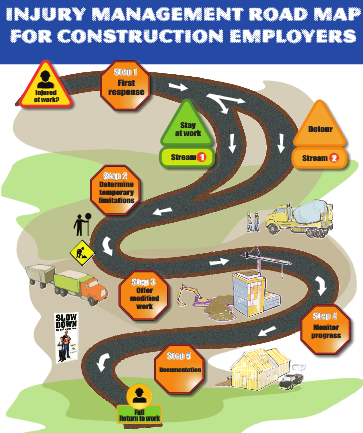
Photo credit: thenestor on Flickr
Here’s a new online resource for simplifying the early return-to-work process for injured workers – originally made for construction but generic enough for employers in any industry.
The Injury Management Road Map was created by a team led by Judy Reilly, client services manager for WorkSafeBC’s Construction & Return-To-Work Services department. I gave her a call to see what employers can get from the new step-by-step guide for employers to follow when a workplace injury occurs.
Judy said the Road Map will help employers deal with the detours and unnecessary bumps in the road, and ensure that the RTW process is managed efficiently and effectively, allowing injured employees to remain at work or return to productive and appropriate work as soon as possible.
The online guide is most useful for small to medium employers who – unlike large employers – don’t have human resources staff on-site to manage RTW programs.
Having all paperwork ready
One useful form, for example, is the Stay-at-work/return-to-work planning form, which provides a typical list of limitations as a starting point for developing a custom return-to-work or modified duties plan. For example, the doctor could select “Limit long periods of walking or standing” or “Avoid jarring” as appropriate. The form can also be downloaded and customized with your own logo, etc.
Judy talked about this problem in the Nov/Dec 2010 issue of WorkSafe Magazine. She said there’s 20 years of research that show it’s “misguided” for injured workers to stay home and rest until fully recovered.
“In general, our physical fitness can start to decline after one week of inactivity,” she told WSM. “So the longer an employee is off work, the longer it takes to get back to full capacity; and the less likely he or she is to return to the job.”
She said an injured worker can transition back into the workplace earlier and more safely when the employer takes immediate steps to accommodate the worker’s injury. Having the right paperwork on hand, when needed, can speed the RTW process, which benefits all.
“The employer can give the RTW package to workers, and tell them: ‘Talk to your doctor about modified duties and bring this back.’ It’s a proactive way that helps the worker and it’s even an education to the physician as they’re going through it,” Judy said. “From the employer’s perspective, they don’t have to create it themselves. It’s all there for them.”
Your experiences with RTW
What kinds of duties do you keep available for modified duties? Have you ever worked on modified duties yourself? Please share your story in the Comments below.



Thanks for sharing Susan. Applies to all jurisdictions and the road map is particularly helpful.